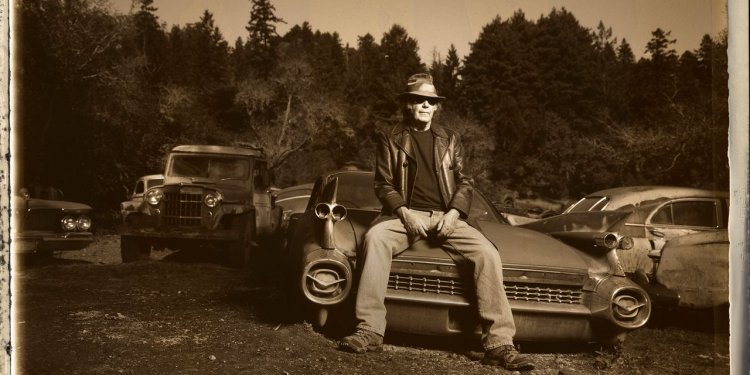‘Chrome Dreams’ by Neil Young Review: From Bootleg to Banner Release
The musician’s new album, a collection recorded for release in the ‘70s but then abandoned, cements his place among that decade’s best singer-songwriters. Neil Young Photo: Danny Clinch By Mark Richardson Aug. 7, 2023 5:50 pm ET Music obsessives of a certain stripe—the type of people who make endless Top 5 lists and recognize themselves in the characters from the 2000 film “High Fidelity,” say—like to argue about the best band or act of a given decade. The Beatles in the ’60s is a common choice, as is Prince in the ’80s. Competition is especially fierce in the ’70s, the height of the LP era, when music sat at the center of the pop-culture conversation. Stevie Wonder ? Excellent choice, probably the most logical. David Bowie ? Also reasonable, especially considering how his stature has grow


Neil Young
Photo: Danny Clinch
Music obsessives of a certain stripe—the type of people who make endless Top 5 lists and recognize themselves in the characters from the 2000 film “High Fidelity,” say—like to argue about the best band or act of a given decade. The Beatles in the ’60s is a common choice, as is Prince in the ’80s. Competition is especially fierce in the ’70s, the height of the LP era, when music sat at the center of the pop-culture conversation. Stevie Wonder ? Excellent choice, probably the most logical. David Bowie ? Also reasonable, especially considering how his stature has grown in the past 15 years. Or Led Zeppelin, a band that changed the sound of hard rock? Or maybe even soul singer Al Green, a master of consistency whose first seven albums of the decade hardly had a weak song? But we also have to consider Neil Young.

During that decade, the Canadian singer-songwriter released eight studio albums and another studio LP with Stephen Stills ; he recorded with Crosby, Stills & Nash; he issued a live album, “Time Fades Away” (1973), filled with all-new songs, many of which are brilliant, and another, “Live Rust” (1979), that’s considered among the best in-concert rock albums ever made. Based purely on what came out at the time, it’s a hugely impressive decade of work, more than enough to put Mr. Young in the running for the most important artist of the ’70s. But those official releases aren’t the entire story.
Mr. Young recorded constantly in the ’70s and made decisions based on instinct, scrapping projects at the last minute for reasons known only to him. Several LPs from the period were readied for release and then abandoned, and for hardcore fans, these obscurities have become the stuff of legend. In the past few years, as part of his Neil Young Archives project, Mr. Young has issued several of these “lost albums.” The latest of these, “Chrome Dreams” (Reprise), out Friday, was originally considered for release in 1977, and was later bootlegged. It’s a fantastic collection of songs that, had it been issued in this form, would have been considered in the upper tier of Mr. Young’s catalog.
All the songs on “Chrome Dreams” eventually came out in one form or another over the years. Some were re-recorded or overdubbed for later issue, while others appear here in the same form as on later releases. The earliest part of the record has the most familiar titles, but the sequencing of “Chrome Dreams” makes them sound new. The set opens with “Pocahontas,” a song that would later become a highlight on “Rust Never Sleeps” and ranks with the most beautiful of Mr. Young’s career. On “Rust,” the song is bathed in reverb with a halo of backing vocals and sound effects. It’s the same recording of Mr. Young’s voice and guitar as is found here, but with additional production. On the raw recording from “Chrome Dreams,” the starkness of this take lends the song an additional sense of loneliness and melancholy.
The hushed “Will to Love” is next, and it barely rises above a whisper; then the downcast “Star of Bethlehem,” which recalls the countrified lope of Mr. Young’s early-’70s material, rounds out the exceptionally mellow opening triptych. This reverie is interrupted by the eight-minute “Like a Hurricane,” a midtempo rocker built as a showcase for Mr. Young’s noisy and knotty electric guitar leads. These three songs, in a different order, opened the second side of Mr. Young’s “American Stars ’n Bars,” the album he released instead of “Chrome Dreams,” but hearing them after the opening “Pocahontas” elevates the material, driving home just how strong Mr. Young’s songwriting was during this era.
The second half of the record ranges from “Captain Kennedy,” which has the flavor of an ancient folk tune and was later included on “Hawks & Doves” (1980); to the gorgeous piano ballad “Stringman,” which was unreleased until 1993, when Mr. Young issued the recording of his “MTV Unplugged” performance; to a slower, bluesier version of “Sedan Delivery,” which appeared in a different recording on “Rust Never Sleeps.” The take of this last track, which hasn’t been released before, is heavier, with a primordial guitar riff that recalls Link Wray’s “Rumble.” “Powderfinger,” another song that appeared on “Rust” in a full-band arrangement, is a Young solo here. While it has none of the other version’s swagger, it puts Mr. Young’s lovely melody in the foreground to poignant effect.
Though Mr. Young is one of the sharpest songwriters in rock history, he’s also something of a collage artist, someone who makes brilliant albums by assembling pieces in a particular juxtaposition. “No one ever mentioned that we were doin’ an album ever,” said guitarist Frank Sampedro of Mr. Young’s backing band Crazy Horse about this period. “We just played and recorded.” Would it have made a difference in Mr. Young’s career if he had released these songs in this order in 1977? It’s impossible to say, but the fact that a record this strong was shelved and then stripped for parts says a lot about how many ideas Mr. Young had in those heady days.
—Mr. Richardson is the Journal’s rock and pop music critic. Follow him on Twitter @MarkRichardson.
What's Your Reaction?













